This is featured post 1 title
Replace these every slider sentences with your featured post descriptions.Go to Blogger edit html and find these sentences.Now replace these with your own descriptions.

This is featured post 2 title
Replace these every slider sentences with your featured post descriptions.Go to Blogger edit html and find these sentences.Now replace these with your own descriptions.

This is featured post 3 title
Replace these every slider sentences with your featured post descriptions.Go to Blogger edit html and find these sentences.Now replace these with your own descriptions.

Changing Roles for Women
 For most women during the early part of the 20th Century, their role mainly consisted of looking after the family and children in the home. Very few women had other jobs. However with the men gone women were also left with shortages of resources, as well as their fears for the future, and the grief and trauma of losing loved ones.
For most women during the early part of the 20th Century, their role mainly consisted of looking after the family and children in the home. Very few women had other jobs. However with the men gone women were also left with shortages of resources, as well as their fears for the future, and the grief and trauma of losing loved ones.
During World War I, it was uncommon for many women to have jobs, apart from domestic serving roles. The number of women working outside the home did increase slightly during this war but mostly in food, clothing and printing industry jobs that were already established as female roles.
 Many women were also actively involved as nurses and in other active service duties, and contributed more actively to war efforts through military service. Other Australian women were also closely connected with war through male relatives and friends away on military service.
Many women were also actively involved as nurses and in other active service duties, and contributed more actively to war efforts through military service. Other Australian women were also closely connected with war through male relatives and friends away on military service.
However, in World War II women were actively recruited into jobs that had always been the preserve of men.
By 1942, the tides of war had shifted to Australia's doorstep and roles changed out of sheer necessity. Australian women entered the workforce in unprecedented numbers and were even allowed to take on 'men's work'. These were jobs for the war, not for life. Women were paid at lower rates than men and expected to 'step down' and return to home duties after the war.
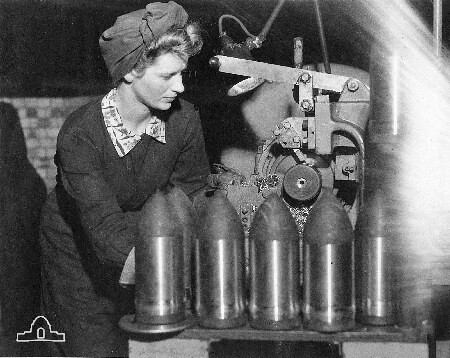 Some of these roles included driving buses, working in factories, shipyards, security guards, mail deliverers, bread carters and The Australian Women's Land Army (AWLA). The AWLA was established in July 1942, in response to labour shortages in country areas. The Women's Land Army recruited women to work on farms where there were no men left to do the hard labour that was traditionally assigned to men. AWLA was not considered a military service and never included benefits such as the pensions, deferred pay and bonuses, which were available to those women who joined Women’s Royal Australian Naval Service (WRANS), Australian Women’s Army Service (AWAS) and others. By 1944 the Australian Women's Land Army had around 3000 members.
Some of these roles included driving buses, working in factories, shipyards, security guards, mail deliverers, bread carters and The Australian Women's Land Army (AWLA). The AWLA was established in July 1942, in response to labour shortages in country areas. The Women's Land Army recruited women to work on farms where there were no men left to do the hard labour that was traditionally assigned to men. AWLA was not considered a military service and never included benefits such as the pensions, deferred pay and bonuses, which were available to those women who joined Women’s Royal Australian Naval Service (WRANS), Australian Women’s Army Service (AWAS) and others. By 1944 the Australian Women's Land Army had around 3000 members.
By the end of the war women were expected to give up their jobs for men who returned home from overseas conflicts, this was often a difficult transition. Many women had enjoyed participating in the workforce, especially the extra income that having a job provided. As a result the 1950s saw a dramatic change in the way women's roles were defined, as females were encouraged back into the home and their traditional roles of wives and mothers reinforced and encouraged.
Exercises:
On a new page in your books put the Heading “Changing Roles for Women”. Under the heading write a 1/2 page summary based upon the information above. After you have completed the summary, download the following resource booklet and read through pages 9 and 10. Answer questions 19, 20, 21, 22, 23, 24 and 25 in your books in full sentences.
Homefront
kokoda
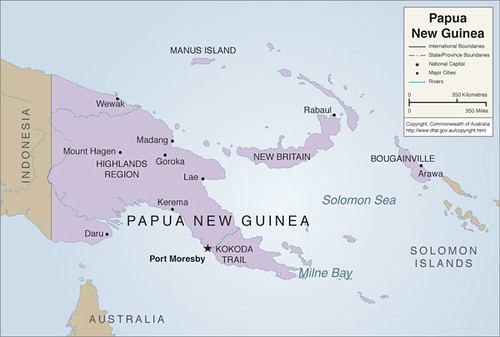
The Kokoda Trail or Track was a path that linked Ower's Corner, approximately 40 km north-east of Port Moresby, and the small village of Wairopi, on the northern side of the Owen Stanley mountain range. From Wairopi, a crossing point on the Kumusi River, the Track was connected to the settlements of Buna, Gona and Sanananda on the north coast.
The name Kokoda, was taken from the village of Kokoda that stood on the southern side of the main range and was the site of the only airfield between Port Moresby and the north coast.
The Japanese had originally planned to capture Port Moresby by a seaborne landing. However this was disrupted by the battle of the Coral Sea, so as a result the Japanese saw the Kokoda Track as a way to capture Port Moresby overland. Troops of the South Seas Detachment began landing at Gona on the 21st July 1942, intending initially just to test the possibility of using the Kokoda Track as a route to invade. Soon the plan was put into action and a full-scale offensive began.
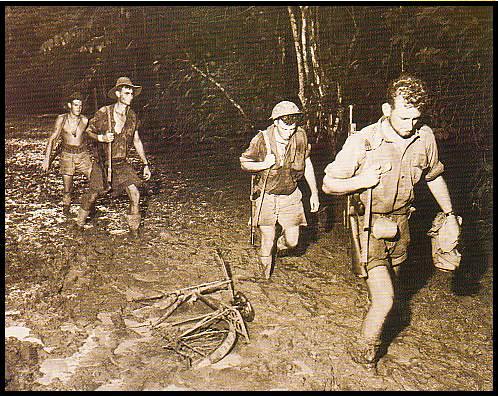 The first fighting occurred between elements of the Papuan Infantry Battalion and the 39th Australian Infantry Battalion at Awala on the 23rd July. Unfortunately the defending forces were unable to hold back the Japanese. They were poorly equipped, did not have effective jungle warfare tactics, and were engaged in fighting at the end of a very long and difficult supply line. A number of desperate delaying actions were fought as the Australians withdrew along the Track. They finally stopped on the 17th September at Imita Ridge, the last natural obstacle along the Track.
The first fighting occurred between elements of the Papuan Infantry Battalion and the 39th Australian Infantry Battalion at Awala on the 23rd July. Unfortunately the defending forces were unable to hold back the Japanese. They were poorly equipped, did not have effective jungle warfare tactics, and were engaged in fighting at the end of a very long and difficult supply line. A number of desperate delaying actions were fought as the Australians withdrew along the Track. They finally stopped on the 17th September at Imita Ridge, the last natural obstacle along the Track.
Although being pushed back was not a desirable outcome, the Australians found themselves in a superior position. Their artillery at Ower's Corner was now in range and their supplies could be trucked most of the way forward. This was in contrast to the Japanese who now had to have their supplies carried all the way from the north coast. As a result of severe losses suffered by the Japanese on the island Guadalcanal, located in the southern Solomon Islands, following the American landing there, the South Seas Detachment was ordered to withdraw to the north coast of Papua and establish a defensive position.
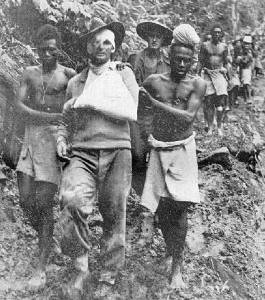 Australian troops of the 25th Brigade then began to edge forward from Imita Ridge on the 23rd September. In the course of their retreat the Japanese fought delaying actions. The conditions that the Australians were forced to purse the Japanese through were hot and humid weather, rain, Tropical Disease, stinking mud and treacherous jungle to name a few. By the 9th December Gona was taken and on the 2nd January 1943 Buna was captured. Sanananda, held by 600 Japanese, was not taken until the 12th January. The Papuan campaign ended with the surrender of Japanese survivors on the 22nd January 1943.
Australian troops of the 25th Brigade then began to edge forward from Imita Ridge on the 23rd September. In the course of their retreat the Japanese fought delaying actions. The conditions that the Australians were forced to purse the Japanese through were hot and humid weather, rain, Tropical Disease, stinking mud and treacherous jungle to name a few. By the 9th December Gona was taken and on the 2nd January 1943 Buna was captured. Sanananda, held by 600 Japanese, was not taken until the 12th January. The Papuan campaign ended with the surrender of Japanese survivors on the 22nd January 1943.
Out of a force of about 20,000 the Japanese had lost 13,000, most of whom had fought to the death rather than surrender. The campaign cost Australia over 6000 casualties.
Exercises:
On a new page in your books put the Heading “Kokoda”. Under the heading write a 1/2 page summary based upon the information above. After you have completed the summary, write the following sub-headings and the questions in your books and answer them in full sentences using the links to the websites listed below.
The Battle for New Guinea
1. Click on Animation, then in the new window click on 'Battle for New Guinea', then 'Battle of the Coral Sea' and read through it.
2. Click on 'Kokoda Track'. What city did Japan sieze and here is it located?
3. Why were the Japanese not able to attack Port Moresby by sea?
4. What was the mountain range that the had to cross?
5. How many troops land on July 21 and what was their intention?
Kokoda Campaign
1. Click on 'Cross-section view of the Kokoda Track'. Describe the conditions the Australians had to endure.
2. Draw a copy of the map into your books.
Fuzzy Wuzzy Angels
1. Who were the Fuzzy Wuzzy Angels?
2. How did they help the Australian forces?
Changing Relationship with America
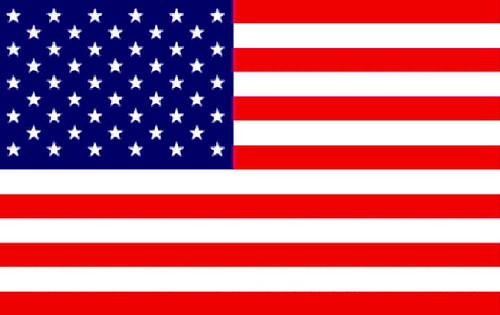 At the beginning of World War II Australia considered itself to be still apart of the British Empire, and as a result always supported Britain’s interests. In 1939 when Britain declared war on Germany, Australia followed Britain’s lead.
At the beginning of World War II Australia considered itself to be still apart of the British Empire, and as a result always supported Britain’s interests. In 1939 when Britain declared war on Germany, Australia followed Britain’s lead.In support of Britain, Australia sent troops from the 6th, 7th and 9th battalion to the Middle East, and 27000 Australians in the air force became involved in the Empire Air Training Scheme that provided air crews to fight in Britain. Australia also sent half of their navy to the Mediterranean to assist in the war effort.
 Australia considered Britain as their ‘Mother Country’ and that in times of crisis Britain would come to Australia’s aid. This belief was supported by the fact that in Singapore stood a British naval force that would act as a front line between Australia and any impending attack from Japan. However on December 10 1941 off the coast of Malaya, two British warships the Prince of Wales and the Repulse, were sunk by Japanese Bombers. This was a major blow to the British presence in the region and Britain’s naval strength at Singapore.
Australia considered Britain as their ‘Mother Country’ and that in times of crisis Britain would come to Australia’s aid. This belief was supported by the fact that in Singapore stood a British naval force that would act as a front line between Australia and any impending attack from Japan. However on December 10 1941 off the coast of Malaya, two British warships the Prince of Wales and the Repulse, were sunk by Japanese Bombers. This was a major blow to the British presence in the region and Britain’s naval strength at Singapore.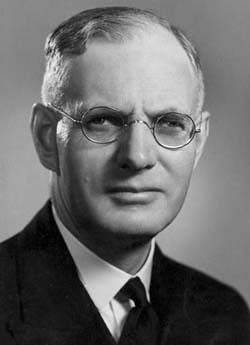 By the end of December 1941, Australia became aware that they were both vulnerable and alone. For Britain could not afford to provide any more support in the South Pacific and Asia regions due to Britain’s increasing problems with Germany in Europe. The Australian government therefore turned to the United States of America for help and in an article in the Melbourne Herald on December 26 1941, Australian Prime Minister John Curtin appealed to America: “Without any inhibitions of any kind I make it quite clear that Australia looks to America, free of any pangs as to our traditional links or kinship with the United Kingdom.”
By the end of December 1941, Australia became aware that they were both vulnerable and alone. For Britain could not afford to provide any more support in the South Pacific and Asia regions due to Britain’s increasing problems with Germany in Europe. The Australian government therefore turned to the United States of America for help and in an article in the Melbourne Herald on December 26 1941, Australian Prime Minister John Curtin appealed to America: “Without any inhibitions of any kind I make it quite clear that Australia looks to America, free of any pangs as to our traditional links or kinship with the United Kingdom.” This appeal caused controversy across the world. For some it meant a disloyal rejection of Britain and for others it meant a bold recognition of Australia's desperate position. Unfortunately for Australia the U.S.A. was not too interested in taking up this role, with the U.S. president famously stating that the appeal “tasted of panic and disloyalty."
This appeal caused controversy across the world. For some it meant a disloyal rejection of Britain and for others it meant a bold recognition of Australia's desperate position. Unfortunately for Australia the U.S.A. was not too interested in taking up this role, with the U.S. president famously stating that the appeal “tasted of panic and disloyalty."By February 1942 the Japanese had defeated British and Australian forces to take control of Singapore. This was the last great protection for Australia. Soon after the fall of Singapore Australia began to endure attacks on the Australian mainland by the Japanese. First with the initial wave of air raids and bombings on the Northern Territory capital city Darwin, then the submarine incursions into Sydney Harbour and finally the sporadic attacks along the eastern coast.
 By March 1942 The American base in the Philippines came under threat by the Japanese. Australia was suddenly seen as a strategic importance to the U.S.A. and as a result of this self interest American President Franklin Roosevelt ordered his Commander in the Pacific, General Douglas MacArthur, to move his headquarters to Australia and take up the role of Supreme Commander of the South West Pacific region.
By March 1942 The American base in the Philippines came under threat by the Japanese. Australia was suddenly seen as a strategic importance to the U.S.A. and as a result of this self interest American President Franklin Roosevelt ordered his Commander in the Pacific, General Douglas MacArthur, to move his headquarters to Australia and take up the role of Supreme Commander of the South West Pacific region.In the years since World War II, Curtin's appeal to America has been seen as the beginning of Australia's alliance with the U.S. and movement away from Britain. This alliance has seen Australia follow the United States of America into many armed conflicts since World War II.
Exercises:
On a new page in your books put the Heading “Change in Relationship with America”. Under the heading write a 1/2 page summary based upon the information above. After you have completed the summary, write the following sub-headings and the questions in your books and answer them in full sentences using the links to the websites listed below.
Battle of the Philippines
1. How many planes did the Japanese use against the Philippines?
2. What time did the Japanese plan to attack and what defences did they expect?
General Douglas MacArthur
1. After the disaster of the Philippines what happened to General MacArthur?
2. What did he expect his troops to do?
Bombing of Darwin and Sydney
 During World War II Darwin, the capital of Australia's Northern Territory, was a major port for the Australian Navy and a major base for the Australian Army. Darwin was used for repairs, re-supply and home for Australian commando units. Being so close to the Asia region, Darwin was considered a strategic location by both Australia and Japan.
During World War II Darwin, the capital of Australia's Northern Territory, was a major port for the Australian Navy and a major base for the Australian Army. Darwin was used for repairs, re-supply and home for Australian commando units. Being so close to the Asia region, Darwin was considered a strategic location by both Australia and Japan.On 19 February 1942 war finally came to Australia for the first time since white settlement.
A fleet of around 200 Japanese aircraft were despatched to attack Darwin from a point off the coast of Timor. Early that morning the aircraft passed over Bathurst Island and Catholic missionaries based there radioed Darwin to warn the Australian mainland. However, the Royal Australian Air Force (RAAF) refused to act on the advice believing the missionaries to be mistaken. As the formation began its run over the city the population went out to watch, thinking the planes were American.
Within minutes large amounts of high explosives began dropping from the sky. Japanese aircraft roared in over the town, attacking the harbour and the airfield.
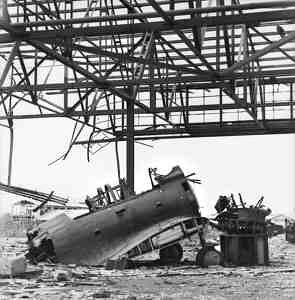 After the first attack, which had done most of its damage in the town and the harbour, a second wave swept in just before midday and concentrated on the airfield.
After the first attack, which had done most of its damage in the town and the harbour, a second wave swept in just before midday and concentrated on the airfield.Virtually unopposed, the attackers left Darwin almost completely decimated. The airfield was a disaster area with a large number of RAAF aircraft destroyed. In the harbour, Australian troopships had been sunk along with a number of cargo vessels. The death toll stood at 243, more than half of which had been on the ships in the harbour with 350 wounded.
Psychologically unprepared for attack, the population understandably panicked. The civilians took to the road in cars, trucks, motor cycles or on foot. There was even panic among servicemen.
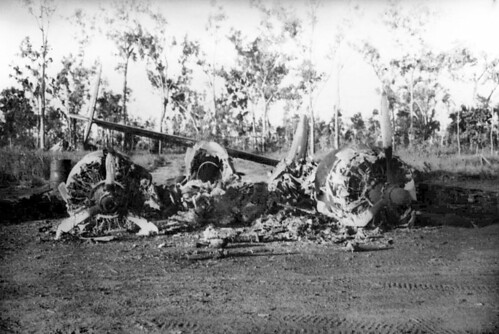 During the bombing numerous servicemen deserted their posts and took to the road with the civilians. In the town, once the fires had been stopped and the dead and injured attended to, a mood of relief was apparent.
During the bombing numerous servicemen deserted their posts and took to the road with the civilians. In the town, once the fires had been stopped and the dead and injured attended to, a mood of relief was apparent.Following the initial attack Darwin was bombed more than 60 times during the course of 1942 and 1943.
Darwin however, was not the only city that would come under attack by the Japanese.
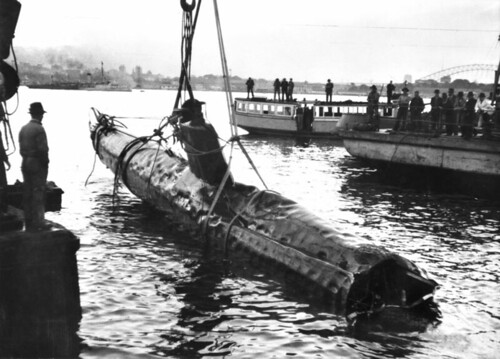 At sunset on Sunday 31 May 1942, there were five Japanese submarines positioned off the New South Wales coast near Sydney. Japanese mother submarines I-22, I-24, and I-27 launched midget submarines about 12kms east of Sydney. These midget submarines infiltrated Sydney Harbour and attempted to torpedo various warships anchored there. The other two submarines, I-21 and I-29, played a supporting role for the midget submarines.
At sunset on Sunday 31 May 1942, there were five Japanese submarines positioned off the New South Wales coast near Sydney. Japanese mother submarines I-22, I-24, and I-27 launched midget submarines about 12kms east of Sydney. These midget submarines infiltrated Sydney Harbour and attempted to torpedo various warships anchored there. The other two submarines, I-21 and I-29, played a supporting role for the midget submarines.Submarine I-21 later shelled Newcastle on 8 June 1942. On the same night Submarine 1-24 also shelled the eastern suburbs of Sydney.
Exercises:
On a new page in your books put the Heading “Australia Stands Alone”. Under the heading write a 1/2 page summary based upon the information above. After you have completed the summary, write the following sub-headings and the questions in your books and answer them in full sentences using the links to the websites listed below.
Air Raids
1. What did the army do in Darwin before the war?
2. When were air raid alerts first sounded?
Using Sources
1. Who is Mr Charles Abbott and what did he do?
2. What similarities does the writer of this article draw between this event and Pearl Harbour?
3. What was Bruce Acland quoted as saying?
Sydney Harbour
1. What was the primary target for the Japanese submarines?
2. What boat was sunk?
3. Take sometime to explore the rest of the site by watching the videos and animation.
Australia Becomes Involved
 In 1939 Germany’s ambition of controlling Europe soon became apparent to France and Britain. After taking over Austria on March 13, 1938 and being handed a large portion of Czechoslovakia at the Munich Conference in September 1938 by Britain and France, Germany took control of the rest of Czechoslovakia in March 1939. Great Britain and France did not want to repeat the bloodshed of World War I and as a result were willing to appease Hitler and avoid another world war by allowing Germany these few concessions. However emboldened by these events, Hitler was confident that he could again move east, this time acquiring Poland without having any other country interfering. As events unfolded, Poland looked toward Britain and France to assist it in the event of a German invasion.
In 1939 Germany’s ambition of controlling Europe soon became apparent to France and Britain. After taking over Austria on March 13, 1938 and being handed a large portion of Czechoslovakia at the Munich Conference in September 1938 by Britain and France, Germany took control of the rest of Czechoslovakia in March 1939. Great Britain and France did not want to repeat the bloodshed of World War I and as a result were willing to appease Hitler and avoid another world war by allowing Germany these few concessions. However emboldened by these events, Hitler was confident that he could again move east, this time acquiring Poland without having any other country interfering. As events unfolded, Poland looked toward Britain and France to assist it in the event of a German invasion.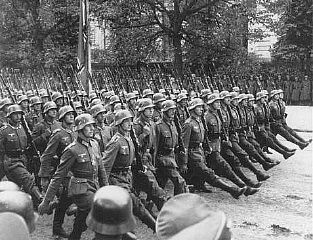 On September 1, 1939, Germany invaded Poland. This event officially marked the beginning of World War II. It was an uneven contest with five German armies consisting of approximately 1.5 million men, 1900 modern aircraft and 2,000 tanks marched upon fewer than a million Polish troops with a small number of armoured vehicles and less than 500 aircraft.
On September 1, 1939, Germany invaded Poland. This event officially marked the beginning of World War II. It was an uneven contest with five German armies consisting of approximately 1.5 million men, 1900 modern aircraft and 2,000 tanks marched upon fewer than a million Polish troops with a small number of armoured vehicles and less than 500 aircraft.The German forces occupied all of the frontier zones within five days and by September 7 their forward units were only 25 miles from Warsaw, the Polish capital. The Polish army was split and encircled with the Polish air forces eliminated. By September 17, the war was virtually over. Ten days later, after a devastating German air assault, Warsaw surrendered.
However, unlike Germany’s earlier incursions into European states, the invasion of Poland provoked a global conflict with Britain and France honouring their pact with Poland and declaring war on Nazi Germany on September 3 when it became clear that negotiating a German withdrawal was not going to achieve its goal.
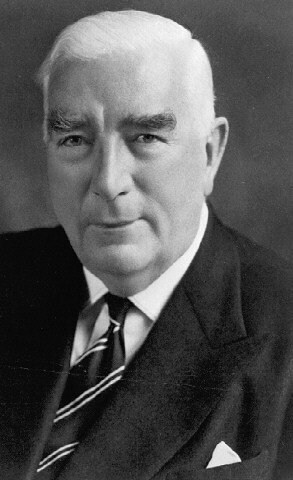 When Britain declared war on Germany, Australia also found that it was again at war. Australian Prime Minister Menzies announced on radio “Fellow Australians. It is my melancholy duty to inform you officially that, in consequence of the persistence of Germany in her invasion of Poland, Great Britain has declared war upon her, and that, as a result, Australia is also at war ... There can be no doubt that where Great Britain stands, there stands the people of the entire British world.”
When Britain declared war on Germany, Australia also found that it was again at war. Australian Prime Minister Menzies announced on radio “Fellow Australians. It is my melancholy duty to inform you officially that, in consequence of the persistence of Germany in her invasion of Poland, Great Britain has declared war upon her, and that, as a result, Australia is also at war ... There can be no doubt that where Great Britain stands, there stands the people of the entire British world.” Initially the Australian Labor Party had resisted and opposed Australia’s involvement in any overseas conflicts. Some Australians felt that the relationship wit Great Britain was not what it once was and that Australia was more of an independent nation. However Prime Minister Menzies was staunchly pro-British and most Australians agreed that Australia should support Britain in this new war effort. Thus it was generally accepted that if Britain was at war, then Australia would be at war.
Initially the Australian Labor Party had resisted and opposed Australia’s involvement in any overseas conflicts. Some Australians felt that the relationship wit Great Britain was not what it once was and that Australia was more of an independent nation. However Prime Minister Menzies was staunchly pro-British and most Australians agreed that Australia should support Britain in this new war effort. Thus it was generally accepted that if Britain was at war, then Australia would be at war.Exercises:
On a new page in your books put the Heading “Australia Becomes Involved”. Under the heading write a 1/2 page summary based upon the information above. After you have completed the summary, write the following sub-headings and the questions in your books and answer them in full sentences using the links to the websites listed below.
Munich 1938
1. What other name was Czechoslovakia known as?
2. Who made up the majority of the population of Czechoslovakia?
3. What did Neville Chamberlain do?
War Declared
1. What did Australia do after war was declared?
2. What did Australia send to help the British?
3. Who did the Australian's fight during the years of 1939 - 1941?
4. Who was the fisrt Australian killed in action?
The Phoney War
1. What was the Maginot Line?
2. What was the Phoney War?
Pearl Harbour
 In October 1938, the President of the United States of America, Franklin Roosevelt, asked Congress for $500m to increase the United States of America's defence forces. This action was done because he believed that Germany was a threat to America. Especially considering the continued German military rearmament program and the events at the Munich conference. The Japanese however, saw this build up as a direct threat to their Empire because, America was the only country in the Pacific which could impede their expansion.
In October 1938, the President of the United States of America, Franklin Roosevelt, asked Congress for $500m to increase the United States of America's defence forces. This action was done because he believed that Germany was a threat to America. Especially considering the continued German military rearmament program and the events at the Munich conference. The Japanese however, saw this build up as a direct threat to their Empire because, America was the only country in the Pacific which could impede their expansion.Japan had prepared war plans to deal with any military intervention by America. The Japanese plan was to conduct one large naval battle against the American Navy, destroying it and resulting in the inability of America to interfere with Japanese expansion throughout Asia. Admiral Isoroku Yamamoto assumed command of the Japan's Combined Fleet in August of 1939. Having lived in America for several years he understood the type of people the Americans were and was able to formulate a attack plan that would catch America off guard.
 In July 1939 a trade embargo was imposed on Japan by Roosevelt in an attempt to stop the Japanese expansion. This resulted in an increased ill-will and additional political problems between the two countries.
In July 1939 a trade embargo was imposed on Japan by Roosevelt in an attempt to stop the Japanese expansion. This resulted in an increased ill-will and additional political problems between the two countries.On January 27, 1941 Joseph C. Grew, the U.S. Ambassador to Japan, wired Washington that he had learned information that in the event of trouble with America, Japan, was planning a surprise attack on Pearl Harbor. No one in Washington believed the information and did not believe that the Japanese could surprise them. Most senior American military experts believed that the Japanese would attack Manila in the Philippine Islands. Another thought to location of attack was toward the north into Russia because of the war in Europe between Germany and the Soviet Union.
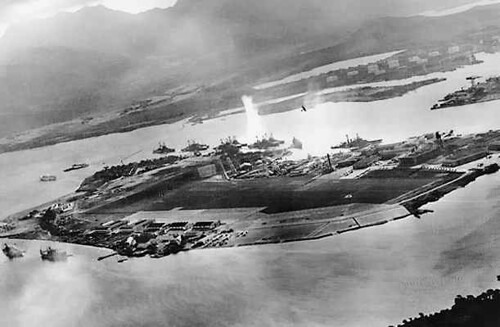 American scientists had developed a machine, code named Magic which gave U.S. intelligence officers the ability to read Japanese secret message and consular traffic, which provided all types of high quality information. However, because of preconceived ideas in Washington and internal politics between the Office of Naval Intelligence, the War Plans Division and the Army's own Intel office some data was not followed up or simply disregarded. As a result important pieces of the pre-attack puzzle were missed.
American scientists had developed a machine, code named Magic which gave U.S. intelligence officers the ability to read Japanese secret message and consular traffic, which provided all types of high quality information. However, because of preconceived ideas in Washington and internal politics between the Office of Naval Intelligence, the War Plans Division and the Army's own Intel office some data was not followed up or simply disregarded. As a result important pieces of the pre-attack puzzle were missed.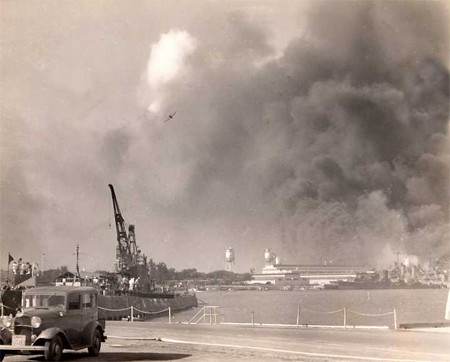 In November 1941, in an attempt to seek a diplomatic solution, Tokyo sent diplomat Saburo Kurusu as a special envoy to Washington to assist Ambassador Admiral Kichisaburo Nomura. Japan wanted the U.S. to agree to its southern expansion diplomatically but if they were unsuccessful, they would go to war.
In November 1941, in an attempt to seek a diplomatic solution, Tokyo sent diplomat Saburo Kurusu as a special envoy to Washington to assist Ambassador Admiral Kichisaburo Nomura. Japan wanted the U.S. to agree to its southern expansion diplomatically but if they were unsuccessful, they would go to war.On Saturday, December 6 1941, the U.S. President Franklin Roosevelt made a final appeal to the Emperor of Japan for peace. There was no reply. Late the same day, the U.S. code-breaking service began intercepting a 14-part Japanese message and deciphered the first 13 parts, passing them on to the President and Secretary of State. The Americans believed a Japanese attack is imminent, most likely somewhere in Southeast Asia.
 On Sunday December 7 the last part of the Japanese message, stating that diplomatic relations with the U.S. are to be broken off, reached Washington in the morning and was decoded at approximately 9 a.m. About an hour later, another Japanese message is intercepted. It instructed the Japanese embassy to deliver the main message to the Americans at 1 p.m. The Americans realized that 1 p.m. Washington time corresponds with early morning time in Pearl Harbour. The U.S. The War Department then sent out an alert but used a commercial telegraph because radio contact with Hawaii was temporarily broken. Delays prevented the alert from arriving at headquarters in Oahu until 12 p.m. (Hawaii time) four hours after the attack had already begun.
On Sunday December 7 the last part of the Japanese message, stating that diplomatic relations with the U.S. are to be broken off, reached Washington in the morning and was decoded at approximately 9 a.m. About an hour later, another Japanese message is intercepted. It instructed the Japanese embassy to deliver the main message to the Americans at 1 p.m. The Americans realized that 1 p.m. Washington time corresponds with early morning time in Pearl Harbour. The U.S. The War Department then sent out an alert but used a commercial telegraph because radio contact with Hawaii was temporarily broken. Delays prevented the alert from arriving at headquarters in Oahu until 12 p.m. (Hawaii time) four hours after the attack had already begun.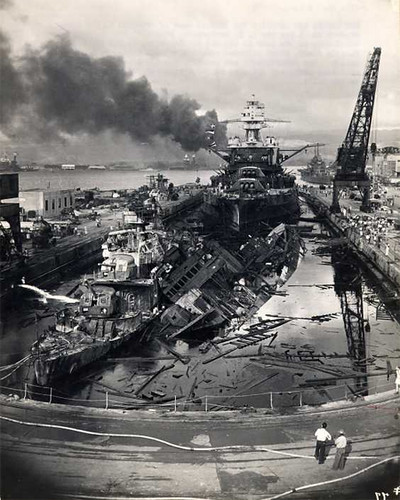 Pearl Harbour was not on a state of high alert as senior commanders had concluded, there was no reason to believe an attack was imminent and since it was Sunday morning, many officers and crewmen were not on duty. Aircraft therefore were left parked wingtip to wingtip on airfields, anti-aircraft guns were unmanned with many ammunition boxes kept locked in accordance with peacetime regulations.
Pearl Harbour was not on a state of high alert as senior commanders had concluded, there was no reason to believe an attack was imminent and since it was Sunday morning, many officers and crewmen were not on duty. Aircraft therefore were left parked wingtip to wingtip on airfields, anti-aircraft guns were unmanned with many ammunition boxes kept locked in accordance with peacetime regulations.The attack began at 7:53 a.m with the Americans being taken completely by surprise. The first attack wave targeted airfields and battleships. The second wave targeted other ships and shipyard facilities. The air raid lasted until 9:45 a.m. Eight battleships are damaged, with five sunk. Three light cruisers, three destroyers and three smaller vessels were lost along with 188 aircraft. The Japanese only lost 27 planes and five midget submarines which attempted to penetrate the inner harbor and launch torpedoes.
Exercises:
On a new page in your books put the Heading “Pearl Harbour”. Under the heading write a 1/2 page summary based upon the information above. After you have completed the summary, write the following sub-heading and the questions in your books and answer them in full sentences using the link to the website listed below.
Note: you will need to click on "Attack Map".
The Events
1. What did the U.S. Minesweeper Condor encounter?
2. What was U.S. Marine Bert Davis' reaction?
3. What happened to the U.S. destroyer Ward?
4. What was U.S. Sailor Will Lehner's reaction?
5. What happened to the radar operators and their report?
6. Explain what happened to each of the moored boats at 7:55 a.m.
Australia Stands Alone
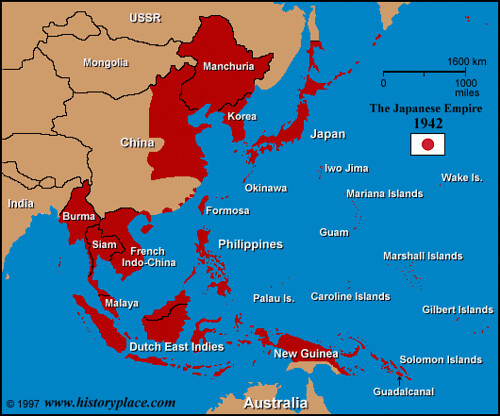 After the Japanese had attacked Pearl Harbour they looked towards Borneo, Burma, Malaya and the Dutch East Indies, which is now known as Indonesia. They also planned to attack Singapore, as this was a strategically important position within the Asia region.
After the Japanese had attacked Pearl Harbour they looked towards Borneo, Burma, Malaya and the Dutch East Indies, which is now known as Indonesia. They also planned to attack Singapore, as this was a strategically important position within the Asia region.The British Allied forces also considered Singapore important, for it was the location of the British Naval base for the defence of the Far East. In support of Britain Australia had stationed a large number of troops in Singapore and as a result, as long as Britain and the Allied forces were present there Australia believed it would be protected from any Japanese attack.
In December 1941 Australian Prime Minister John Curtin appealed to the United States of America for help, however much to Australia’s dismay America was unwilling to commit forces at that time.
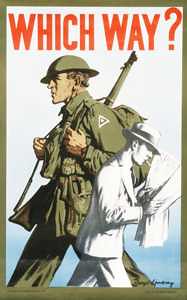 On 15 February 1942, the Japanese captured Singapore after devastating air attacks and land battles in which the Japanese travelled through the Malay Peninsula. A substantial amount of Allied and Australian troops were captured and interned into POW camps. For Australians this event was of serious concern, for Japan had just gotten closer to the Australian main land and defeated what was considered to be Australia’s best defence position. Suddenly Australia was left all alone in the Pacific.
On 15 February 1942, the Japanese captured Singapore after devastating air attacks and land battles in which the Japanese travelled through the Malay Peninsula. A substantial amount of Allied and Australian troops were captured and interned into POW camps. For Australians this event was of serious concern, for Japan had just gotten closer to the Australian main land and defeated what was considered to be Australia’s best defence position. Suddenly Australia was left all alone in the Pacific.On the home front there was a real fear of an invasion by the Japanese. During 1942, civilians were evacuated south in Western Australia, Queensland and the Northern Territory and Australians were put under greater government controls than at any time since the convict era.
These controls were implemented through the authority of the National Security Act of 1939. This Act did two major things: it effectively overrode the Constitution for the duration of the war - giving the Commonwealth power to make laws in areas where it did not have that power under the Constitution; and it effectively overrode the power of parliament by giving the government power to make regulations, that is, laws that required only the signatures of some ministers and the Governor-General.
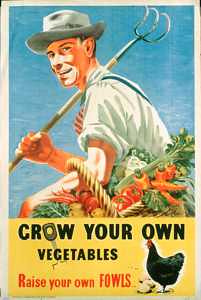 The laws and regulations affected all areas of people's lives. Some of these were:
The laws and regulations affected all areas of people's lives. Some of these were:• The reduction of the Christmas - New Year holiday period to three days
• The restriction of weekday sporting events
• Blackouts and brownouts in cities and coastal areas
• Increased call-ups of the Militia
• The issue of personal identity cards
• The rationing of clothing, footwear, tea, butter and sugar
• The banning of the Communist Party
Exercises:
On a new page in your books put the Heading “Australia Stands Alone”. Under the heading write a 1/2 page summary based upon the information above. After you have completed the summary, write the following sub-headings and the questions in your books and answer them in full sentences using the links to the websites listed below.
The Japanese Advance
1. How long did it take for the Japanese to take control of Singapore and Malalya?
2. What was Rabaul?
3. What areas did the Japanese control by the end of March 1942?
The Homefront
1. How many armies did Australia have in 1941 and how were they different?
2. What did the Australian Prime Minister do at the end of 1942?
3. What was General Douglas MacArthur's argument?
4. What happened during the 'austerity campaign'?
Rise of Fascism
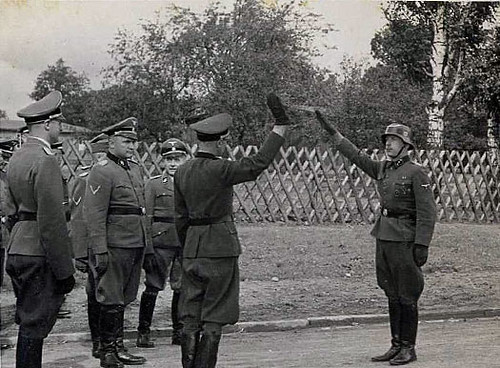 The years between 1919 and 1945 have sometimes been called the age of fascism. We have all heard of the Nazis and fascists, but our perception of these people is usually a German soldier wearing a grey or black uniform with a swastika on their left arm, whilst holding their right arm high toward the sky. However whilst this image maybe the most famous symbol of fascism, it is not the whole story.
The years between 1919 and 1945 have sometimes been called the age of fascism. We have all heard of the Nazis and fascists, but our perception of these people is usually a German soldier wearing a grey or black uniform with a swastika on their left arm, whilst holding their right arm high toward the sky. However whilst this image maybe the most famous symbol of fascism, it is not the whole story.The word NAZI was the acronym for the National Socialist German Worker's Party. It was a fascist movement that had its roots in the European nationalist and socialist movements, and had developed a biological view of so-called superiority, with the "Aryan" race being at the top of the warped biological ladder. See: Timeline of Nazi Persecution and Genocide.
Fascists were characterised by elements such as their opposition to communism, extreme right wing and racist views, belief in the superiority of their own nation or race, use of violence and/or force to quell any opposition and total control of the state by a single dictator.
All fascist movements, racialist or not, share this last element. In the most basic sense, it is the ideology of political opportunism in a drive to attain and hold total state power. On that road to power, fascists are willing to abandon any principle to adopt any issue more popular and more likely to gain converts.
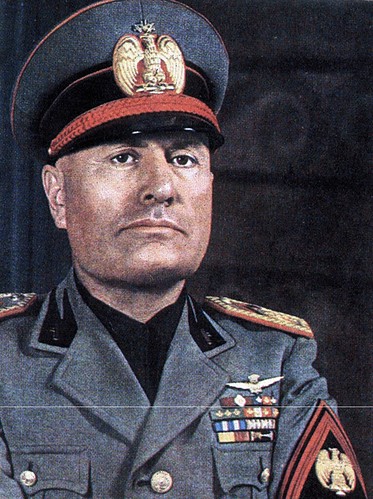 Italy is considered to be the birthplace of fascist ideology. Benito Mussolini, a former socialist journalist, organized the first fascist movement in 1919 at Milan. The movement was called the Fasci Italiani di Combattimento (Italian Fighting League), and consisted of 200 members. The group, led by one of Mussolini's close confidants, Dino Grandi, formed armed squads of war veterans called Blackshirts (or squadristi) to terrorize socialists, anarchists, and communists. The group grew so rapidly that within two years, it transformed itself into the National Fascist Party at a congress in Rome. In October 1922 Mussolini led a march on Rome and ousted the then Prime Minister Luigi Facta. Once in power he began transforming the Italian political system into a fascist state.
Italy is considered to be the birthplace of fascist ideology. Benito Mussolini, a former socialist journalist, organized the first fascist movement in 1919 at Milan. The movement was called the Fasci Italiani di Combattimento (Italian Fighting League), and consisted of 200 members. The group, led by one of Mussolini's close confidants, Dino Grandi, formed armed squads of war veterans called Blackshirts (or squadristi) to terrorize socialists, anarchists, and communists. The group grew so rapidly that within two years, it transformed itself into the National Fascist Party at a congress in Rome. In October 1922 Mussolini led a march on Rome and ousted the then Prime Minister Luigi Facta. Once in power he began transforming the Italian political system into a fascist state.Like other fascist groups of the time, they took advantage of the social and political crisis affecting their country after Word War I and the 1929 stock market crash. In 1938 Mussolini forced the last vestige of democracy, the Council of Deputies, to vote themselves out of existence, leaving Mussolini to become the fascist dictator of Italy.
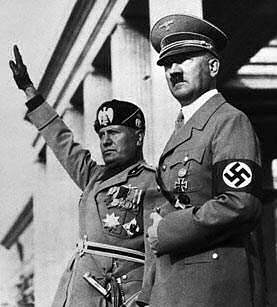 In the 1930’s both France and Britain hoped to gain support from Italy with regards to opposing Germany’s ever-increasing aggressiveness in the European area. However Mussolini was not interested as he had ambitions to expand his own empire and as a result in 1935 Italy invaded Abyssinia, a North African state. Mussolini aligned himself with Germany and in 1936 formed the Rome-Berlin Axis.
In the 1930’s both France and Britain hoped to gain support from Italy with regards to opposing Germany’s ever-increasing aggressiveness in the European area. However Mussolini was not interested as he had ambitions to expand his own empire and as a result in 1935 Italy invaded Abyssinia, a North African state. Mussolini aligned himself with Germany and in 1936 formed the Rome-Berlin Axis.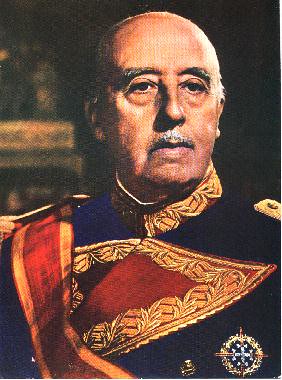 Also in 1936 a Spanish General, Francisco Franco, claimed state power in Spain by leading a military revolt against the Republican government. Both Mussolini and Hitler and supported Franco’s take over by supplying him with troops, bombers and transport aircraft. Many people from other countries came to the aid of the Spanish government by volunteering to fight the fascists in an effort to stop the spread of fascism through Europe. They were unsuccessful.
Also in 1936 a Spanish General, Francisco Franco, claimed state power in Spain by leading a military revolt against the Republican government. Both Mussolini and Hitler and supported Franco’s take over by supplying him with troops, bombers and transport aircraft. Many people from other countries came to the aid of the Spanish government by volunteering to fight the fascists in an effort to stop the spread of fascism through Europe. They were unsuccessful.Exercises:
On a new page in your books put the Heading “Rise of Fascism”. Under the heading write a 1/2 page summary based upon the information above. After you have completed the summary, write the following sub-heading and the questions in your books and answer them in full sentences using the link to the websites listed below.
Fascism in Europe
1. What countries were part of the Axis (fascists states) in 1933?
2. What did Germany do in 1934?
3. What did Italy do in 1935?
4. What did Spain do in 1939?
5. What did Germany do in 1939?
6. What did Italy do in 1939?
7. What countries did Germany invade in 1940?
Adolf Hitler
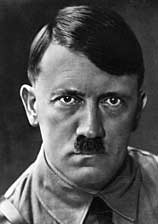 Adolf Hitler was born on 20 April 1889 in Braunau-am-Inn on the Austrian-German border. His father was a customs official. Hitler left school at 16 with no qualifications and struggled to make a living as a painter in Vienna. This was where many of his extreme political and racial ideas originated.
Adolf Hitler was born on 20 April 1889 in Braunau-am-Inn on the Austrian-German border. His father was a customs official. Hitler left school at 16 with no qualifications and struggled to make a living as a painter in Vienna. This was where many of his extreme political and racial ideas originated.In 1913, he moved to Munich and, on the outbreak of World War I, enlisted in the German army, where he was wounded and awarded the Iron Cross medal. In 1919 he joined the extreme right wing (fascist) German Workers' Party (DAP). As propaganda minister for the party, he promised extremist 'remedies' to Germany's post-war problems, such as the Depression, unemployment and the weak global position Germany had been forced into after losing World War I, which he and many others blamed on Jews and Bolsheviks. 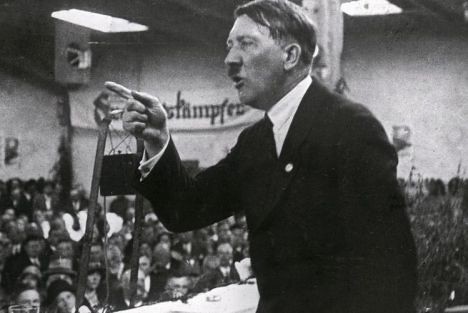 By 1921 he was the unquestioned leader of what was now called the National Socialist German Workers' Party (NSDAP or Nazi Party).
By 1921 he was the unquestioned leader of what was now called the National Socialist German Workers' Party (NSDAP or Nazi Party).
 By 1921 he was the unquestioned leader of what was now called the National Socialist German Workers' Party (NSDAP or Nazi Party).
By 1921 he was the unquestioned leader of what was now called the National Socialist German Workers' Party (NSDAP or Nazi Party).In 1923 Hitler attempted an unsuccessful armed uprising in Munich and was imprisoned for nine months, during which time he dictated 'Mein Kampf', a semi-autobiography, outlining his political ideology and ideas on propaganda. On his release he began to rebuild the Nazi Party and used new techniques of mass communication, backed up with violence, to get his message across. The Nazi party eventually grew stronger and in the 1932 elections became the largest party in the German parliament.  In January 1933 Hitler became chancellor of a coalition government. He quickly took dictatorial powers and began to institute anti-Jewish laws and in 1935, Hitler proclaimed the Nuremberg Racial Laws that deprived Jews of their civil rights and paved the way for their persecution. He also began the process of German militarisation and territorial expansion that would eventually lead to World War II. He allied with Italy and later Japan to create the Axis.
In January 1933 Hitler became chancellor of a coalition government. He quickly took dictatorial powers and began to institute anti-Jewish laws and in 1935, Hitler proclaimed the Nuremberg Racial Laws that deprived Jews of their civil rights and paved the way for their persecution. He also began the process of German militarisation and territorial expansion that would eventually lead to World War II. He allied with Italy and later Japan to create the Axis.
 In January 1933 Hitler became chancellor of a coalition government. He quickly took dictatorial powers and began to institute anti-Jewish laws and in 1935, Hitler proclaimed the Nuremberg Racial Laws that deprived Jews of their civil rights and paved the way for their persecution. He also began the process of German militarisation and territorial expansion that would eventually lead to World War II. He allied with Italy and later Japan to create the Axis.
In January 1933 Hitler became chancellor of a coalition government. He quickly took dictatorial powers and began to institute anti-Jewish laws and in 1935, Hitler proclaimed the Nuremberg Racial Laws that deprived Jews of their civil rights and paved the way for their persecution. He also began the process of German militarisation and territorial expansion that would eventually lead to World War II. He allied with Italy and later Japan to create the Axis.Hitler's invasion of Poland in September 1939 began World War II. After military successes in Denmark, Norway and Western Europe, but after failing to subdue Britain in 1941, Hitler ordered the invasion of the Soviet Union.  The Jewish populations of the countries conquered by the Nazis were rounded up and killed. Millions of others whom the Nazis considered racially inferior were also killed or worked to death. In December 1941, Hitler declared war on America. The war on the eastern front drained Germany's resources and in June 1944, the British and Americans landed in France. With Soviet troops poised to take the German capital, Hitler committed suicide in his bunker in Berlin on 30 April 1945.
The Jewish populations of the countries conquered by the Nazis were rounded up and killed. Millions of others whom the Nazis considered racially inferior were also killed or worked to death. In December 1941, Hitler declared war on America. The war on the eastern front drained Germany's resources and in June 1944, the British and Americans landed in France. With Soviet troops poised to take the German capital, Hitler committed suicide in his bunker in Berlin on 30 April 1945.
 The Jewish populations of the countries conquered by the Nazis were rounded up and killed. Millions of others whom the Nazis considered racially inferior were also killed or worked to death. In December 1941, Hitler declared war on America. The war on the eastern front drained Germany's resources and in June 1944, the British and Americans landed in France. With Soviet troops poised to take the German capital, Hitler committed suicide in his bunker in Berlin on 30 April 1945.
The Jewish populations of the countries conquered by the Nazis were rounded up and killed. Millions of others whom the Nazis considered racially inferior were also killed or worked to death. In December 1941, Hitler declared war on America. The war on the eastern front drained Germany's resources and in June 1944, the British and Americans landed in France. With Soviet troops poised to take the German capital, Hitler committed suicide in his bunker in Berlin on 30 April 1945.Exercises:
On a new page in your books put the Heading “Adolf Hitler”. Under the heading write a 1/2 page summary based upon the information above. After you have completed the summary, write the following sub-headings and the questions in your books and answer them in full sentences using the links to the websites listed below.
Hitler in Detail
1. How many brothers and sisters did Adolf have and what were their names?
2. What happened to them?
3. Describe Hitler's education.
4. What happened to Hitler in 1909?
5. Who was Hitler sent to spy on between the years 1918 and 1919 and what happened?
6. Who were the S.A.?
7. What happened on the 8th November 1923?
8. What was Hitler charged with and what was the sentence?
9. How long did he serve?
10. Who were the SS?
11. What happened in February 1933?
12. What happened in March 1933?
Using Sources
1. Looking at the photos of Hitler, how did his image change? Why do you think he did this?
2. Using this link, look at the various video footage of Hitler. What kind of person do you think Hitler is portrayed as being? Explain your answer.
3. Use this link to read some famous quotes by Hitler.
Japanese Expansion
Japan modernized between 1868 and World War I. 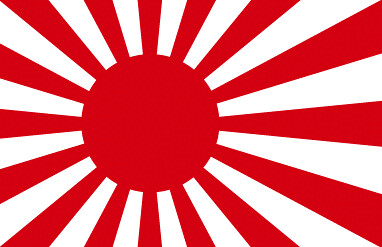 It emerged as a modern industrial economy with giant companies that assumed great importance as trading enterprises and in World War One, Japan had acquired the German islands north of the Equator. The Japanese mainland was barely touched by World War I and as a result Japanese industry had expanded to fill the gap left by Europe's devastated industry. However Japan had an ever increasing and demanding population and did not have sufficient natural resources to sustain itself.
It emerged as a modern industrial economy with giant companies that assumed great importance as trading enterprises and in World War One, Japan had acquired the German islands north of the Equator. The Japanese mainland was barely touched by World War I and as a result Japanese industry had expanded to fill the gap left by Europe's devastated industry. However Japan had an ever increasing and demanding population and did not have sufficient natural resources to sustain itself.
 It emerged as a modern industrial economy with giant companies that assumed great importance as trading enterprises and in World War One, Japan had acquired the German islands north of the Equator. The Japanese mainland was barely touched by World War I and as a result Japanese industry had expanded to fill the gap left by Europe's devastated industry. However Japan had an ever increasing and demanding population and did not have sufficient natural resources to sustain itself.
It emerged as a modern industrial economy with giant companies that assumed great importance as trading enterprises and in World War One, Japan had acquired the German islands north of the Equator. The Japanese mainland was barely touched by World War I and as a result Japanese industry had expanded to fill the gap left by Europe's devastated industry. However Japan had an ever increasing and demanding population and did not have sufficient natural resources to sustain itself.With the onset of the Great Depression the Japanese government had no solutions to the problems that were presented by the worldwide economic climate. 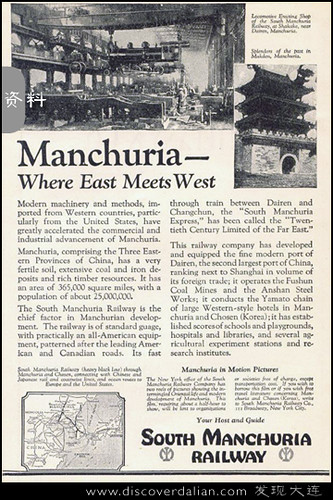 The unemployed of Japan looked to the strength of the army to assist their plight rather than to the weak politicians. As a result the Japanese government looked towards taking over provinces of China by force to acquire their resource needs. Japan attacked Manchuria in 1931 and began to invest vast sums of money into the economy of Manchuria, which was effectively controlled by the South Manchuria Railway Company.
The unemployed of Japan looked to the strength of the army to assist their plight rather than to the weak politicians. As a result the Japanese government looked towards taking over provinces of China by force to acquire their resource needs. Japan attacked Manchuria in 1931 and began to invest vast sums of money into the economy of Manchuria, which was effectively controlled by the South Manchuria Railway Company.
 The unemployed of Japan looked to the strength of the army to assist their plight rather than to the weak politicians. As a result the Japanese government looked towards taking over provinces of China by force to acquire their resource needs. Japan attacked Manchuria in 1931 and began to invest vast sums of money into the economy of Manchuria, which was effectively controlled by the South Manchuria Railway Company.
The unemployed of Japan looked to the strength of the army to assist their plight rather than to the weak politicians. As a result the Japanese government looked towards taking over provinces of China by force to acquire their resource needs. Japan attacked Manchuria in 1931 and began to invest vast sums of money into the economy of Manchuria, which was effectively controlled by the South Manchuria Railway Company.However Japan had the problem that the Soviet Union was geographically a close neighbour to China and as a result could hinder a Japanese conquest of the greater Asia area. Japan needed allies to support them in the event of a war with the Soviet Union. Adolf Hitler of Germany was happy to help and the two nations signed the Anti-Comintern pact in November 1936.
The Japanese aggression into China also presented a problem with the United States of America, 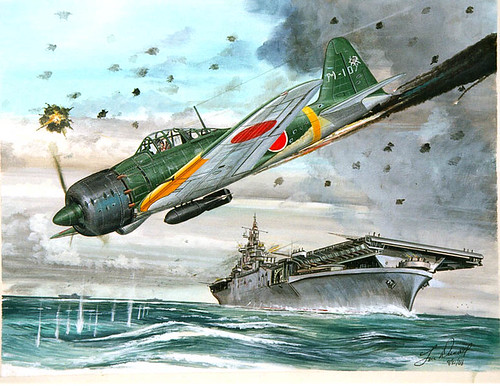 as they had commercial interests in China. Hitler, not wanting to confront the USA signed an agreement with Japan and Italy in September 1940 titled the Tripartite Pact. This pact ensured that if the United States entered the war they would have to face Japan, Italy and Germany.
as they had commercial interests in China. Hitler, not wanting to confront the USA signed an agreement with Japan and Italy in September 1940 titled the Tripartite Pact. This pact ensured that if the United States entered the war they would have to face Japan, Italy and Germany.
 as they had commercial interests in China. Hitler, not wanting to confront the USA signed an agreement with Japan and Italy in September 1940 titled the Tripartite Pact. This pact ensured that if the United States entered the war they would have to face Japan, Italy and Germany.
as they had commercial interests in China. Hitler, not wanting to confront the USA signed an agreement with Japan and Italy in September 1940 titled the Tripartite Pact. This pact ensured that if the United States entered the war they would have to face Japan, Italy and Germany.Exercises:
On a new page in your books put the Heading “Japanese Empire Expansion”. Under the heading write a 1/2 page summary based upon the information above. After you have completed the summary, write the following sub-headings and the questions in your books and answer them in full sentences using the links to the websites listed below.
Japan and Manchuria
1. Why did Japan invade Manchuria?
2. What year did Japan invade Manchuria?
3. What was the League?
4. What did Japan do to protect its investments?
5. What was the excuse that Japan used?
6. Explain what happened between the Japanese government and the army?
Using Sources
1. Using Source C, what does this tell historians about the attitude of the British towards Japan's empire expansion? Explain your answer
2. Using Source D, What is the cartoonist suggesting about the League, the Japanese army, John Simon and other western diplomats? Explain your answer
3. Using Source E, What is the cartoonist suggesting about Japan? Explain your answer
4. Using this Map, list the countries that border the Japanese controlled area
5. What impact do you think the size and proximity of this area could possibly have on Australia? Explain your answer
6. Using the same map, click on the word "Japan" and from the information available in the new window, draw a timeline in your books beginning at 18th September 1931 and ending at 7th December 1941
Jack Lang
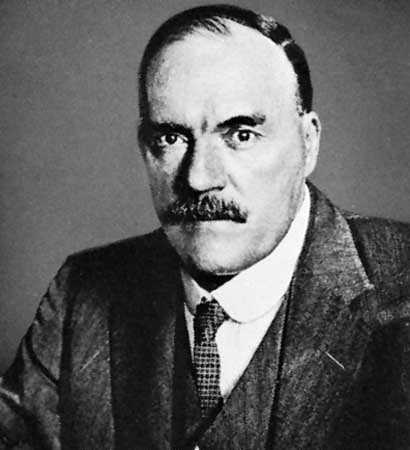 John (Jack) Thomas Lang was an estate agent and politician, he was born on 21 December 1876 in George Street, Sydney.
John (Jack) Thomas Lang was an estate agent and politician, he was born on 21 December 1876 in George Street, Sydney.In 1903 Lang was the secretary of the Granville Labour League and in 1913 he was president of the Granville Electoral Council. He was associated with St Joseph's Hospital and took part in Catholic social life. In 1907-14 he represented Newington Ward on the Auburn council and was mayor in 1909-11.
In 1920 Labour narrowly won the state election, held under proportional representation. Lang gained one of the Parramatta seats and became treasurer in the Storey ministry; he continued in office until the fall of the Dooley government in 1922.
Lang knew that members of the Communist Party of Australia had infiltrated the Labour Party, and he was determined to eliminate them. He was always relentlessly opposed to communism. But he also argued that 'Capitalism must go'. Conservative forces, already fearing him, responded with a constant attack linking Labour with revolution, even after communists were banned in 1924.
In June of 1924 Lang won an internal party vote to become leader of the state Labour party. Lang then led the Labour party to victory in the 1925 state election. However due to a number of reasons Lang ended up losing the next election in 1927.
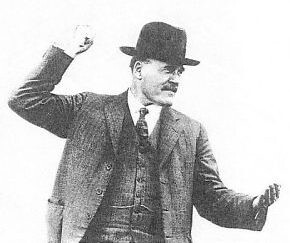 By 1930 the Depression was now biting, with severe unemployment and balance of payments problems forcing deflationary policies. Lang’s policy for the October general election included extensive public works to reduce unemployment, restoration of reductions in public service salaries, markets for farmers' produce, and double payment for each family's first child. He also promised to balance the budget. He won the election by twenty seats.
By 1930 the Depression was now biting, with severe unemployment and balance of payments problems forcing deflationary policies. Lang’s policy for the October general election included extensive public works to reduce unemployment, restoration of reductions in public service salaries, markets for farmers' produce, and double payment for each family's first child. He also promised to balance the budget. He won the election by twenty seats.In December Lang's legislation gave relief to mortgagors and tenants, and restricted evictions and the sale of tenants' furniture. However, Hard-pressed for revenue, he introduced a State lottery, a 10 per cent tax on winning bets, and increased the unemployment tax on wages and salaries from threepence to one shilling in the pound.
At a Federal-States conference in Canberra in February 1931 it was agreed that budgets should be balanced within three years. Lang proposed 'the Lang Plan', that interest payments to British bondholders should be suspended, that interest on Australian government borrowings should be reduced to 3 per cent, and that a new form of currency should be based on 'the goods standard'. In March 1931 Lang announced that interest due in London on 1 April would not be paid; he said dole commitments should come first.
In May the Government Savings Bank of New South Wales was forced to close. Next month the Premiers' Conference in Melbourne with Lang's agreement adopted a severe deflationary policy, including cuts in wages and pensions.
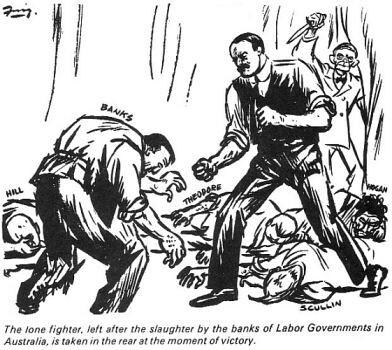 In 1932 he faced charges of corruption in the operation of the 'tin hares' in parliament and the federal Prime Minister J. A. Lyons's Financial Agreements Enforcement Act provoked Lang to withdraw more than £1 million in cash from two Sydney banks. The Federal government then used its new powers to take over the revenues of New South Wales, depriving Lang of banking facilities. Massive demands were made on the governor to dismiss him.
In 1932 he faced charges of corruption in the operation of the 'tin hares' in parliament and the federal Prime Minister J. A. Lyons's Financial Agreements Enforcement Act provoked Lang to withdraw more than £1 million in cash from two Sydney banks. The Federal government then used its new powers to take over the revenues of New South Wales, depriving Lang of banking facilities. Massive demands were made on the governor to dismiss him.Governor Game had been examining Lang's circular instructing public servants not to pay money into the Federal Treasury as required by law. He judged it was illegal. Lang refused to withdraw it and on 13 May 1932 the governor dismissed him. Constitutionally the grounds were dubious as the courts had the duty to determine illegality; but socially and politically Game was justified. Civil disorder threatened; Lang's inner resources were exhausted, his policies as bankrupt as his Treasury, his popular backing decimated.
Exercises:
On a new page in your books put the Heading “Jack Lang”. Under the heading write a 1/2 page summary based upon the information above. After you have completed the summary, write the following sub-headings and the questions in your books and answer them in full sentences using the links to the websites listed below.
Economic Crisis
1. What was Niemeyer's Plan? Explain.
2. What was Lang's Plan? Explain.
3. What was the relationship between The New Guard and the Lang government? Explain.
Extreme Politics
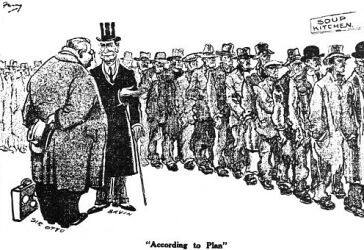 The growth of private armies was an unexpected and disturbing reaction to the depression in Australia. The best known of these were the ‘New Guard’ and the ‘White Army’. These groups were usually made up of World War I veterans and organised along military lines. The New Guard was led by ex AIF officer, Eric Campbell. He and his followers feared that the unemployed workers might turn to communism to solve the economic problems of the day.
The growth of private armies was an unexpected and disturbing reaction to the depression in Australia. The best known of these were the ‘New Guard’ and the ‘White Army’. These groups were usually made up of World War I veterans and organised along military lines. The New Guard was led by ex AIF officer, Eric Campbell. He and his followers feared that the unemployed workers might turn to communism to solve the economic problems of the day.In early 1933 Eric Campbell toured Europe to supplement his 'data about Fascism'. In London he met representatives of both the British Union of Fascists (BUF) and the Imperial Fascist League. Brandishing a letter of introduction from the BUF's Sir Oswald Mosley, Campbell continued his European fascist tour, seeking audiences with Benito Mussolini and Adolf Hitler. In Berlin the New Guard leader observed 100,000 Nazis rallying in front of the Imperial Palace in Unter den Linden. He was highly impressed.
 In 1931 the advent of an aggressive right-wing movement in the form of the New Guard hardly came as a major surprise to members of the Australian labour movement. Throughout the 1920s labour papers had warned about the dangers of a Mussolini-style movement emerging in Australia and kept diligent watch over any suggestions that this was happening. The intelligence facility of the Communist Party of Australia (CPA) also advised caution and vigilance about the machinations of the party's far-right opponents.
In 1931 the advent of an aggressive right-wing movement in the form of the New Guard hardly came as a major surprise to members of the Australian labour movement. Throughout the 1920s labour papers had warned about the dangers of a Mussolini-style movement emerging in Australia and kept diligent watch over any suggestions that this was happening. The intelligence facility of the Communist Party of Australia (CPA) also advised caution and vigilance about the machinations of the party's far-right opponents.The labour response to the New Guard was immediately and uniformly hostile. Labour and leftist newspapers across the political spectrum as well as trade union, communist, unemployed and Labour Party organisations, all denounced the New Guard. The NSW Labour Council and state ALP executive attacked it as a 'Fascist organisation', as did the major trade unions, and rank and file activists and individual ALP and trade union branches.
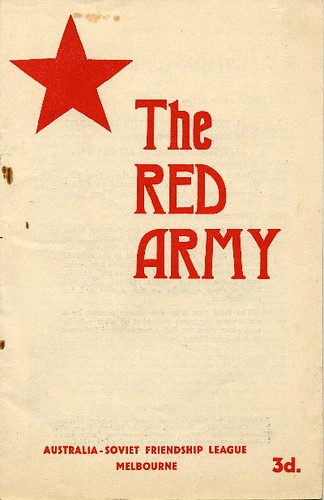 In December 1931, the communist group United Front against Fascism (UFAF) was formed. At suburban meetings in early 1932 the UFAF warned that the New Guard had declared “open war …upon all members of the Working Class”.
In December 1931, the communist group United Front against Fascism (UFAF) was formed. At suburban meetings in early 1932 the UFAF warned that the New Guard had declared “open war …upon all members of the Working Class”.Communists agreed that the depression was proof of the failings of a capitalist system and pointed to an idealised version of life in Russia as an example of a state where there was full employment. Communists groups were often involved in political actions aimed at improving conditions for the unemployed.
The New Guard however, believed that they could maintain law and order by taking over the running of the state in the event of a communist uprising. In reality they used fear to attack any political group they disagreed with.
Exercises:
On a new page in your books put the Heading “Extreme Politics”. Under the heading write a 1/2 page summary based upon the information above. After you have completed the summary, write the following sub-headings and the questions in your books and answer them in full sentences using the links to the websites listed below.
The New Guard
1. Who were the New Guard?
2. How many members did the New Guard have?
3. What did they do in Sydney?
4. Find and write down the definition of "coup d'etat".
5. What other well known personalities were members of the New Guard?
6. What was their goal and what did they want to stop happening?
Communist Party of Australia
1. Who formed the the Communist Party of Australia?
2. Where did they hold their meetings?
3. What was the name of their paper?
4. What was the Union's attitude to the party?
Sydney Harbour Bridge
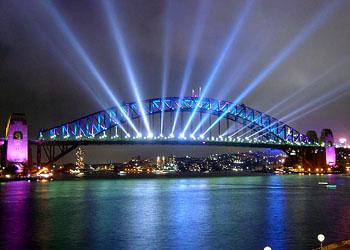 The Sydney Harbour Bridge was opened on March 19th 1932 by Premier Jack Lang, after six years of construction. On the day it is estimated that between 750,000 and one million people were present within the city and around the harbour foreshores for the event. Made of steel, the bridge contains 6 million hand driven rivets. The surface area that requires painting is equal to about the surface area of 60 sports fields. The Bridge has huge hinges to absorb the expansion caused by the hot Sydney sun.
The Sydney Harbour Bridge was opened on March 19th 1932 by Premier Jack Lang, after six years of construction. On the day it is estimated that between 750,000 and one million people were present within the city and around the harbour foreshores for the event. Made of steel, the bridge contains 6 million hand driven rivets. The surface area that requires painting is equal to about the surface area of 60 sports fields. The Bridge has huge hinges to absorb the expansion caused by the hot Sydney sun.When it opened it cost a car 6 pence to cross. A horse and rider was 3 pence.
Sydney Harbour Bridge is the world's largest, but not longest, steel arch bridge, and has become a renowned international symbol of Australia.
 After inviting worldwide tenders in 1922, the New South Wales Government received twenty proposals from six companies and on 24 March 1924; the contract, worth 4,217,721 pounds 11 shillings and 10 pence, was awarded to the English firm Dorman Long and Co. of Middlesbrough.
After inviting worldwide tenders in 1922, the New South Wales Government received twenty proposals from six companies and on 24 March 1924; the contract, worth 4,217,721 pounds 11 shillings and 10 pence, was awarded to the English firm Dorman Long and Co. of Middlesbrough.The general design was prepared by Dr J.J.C Bradfield and officers of the NSW Department of Public Works, while the detailed design and crucial erection process were undertaken by the contractors consulting engineer Mr Ralph Freeman of Sir Douglas Fox and Partners and his associate Mr. G.C Imbault.
The foundations for the four main bearings, which carry the full weight of the main span were dug to a depth of 12.2 metres and filled with special reinforced high-grade concrete laid in hexagonal formations.
The four decorative 89 metre high pylons are made of concrete, faced with granite, quarried near Moruya, where about 250 Australian, Scottish and Italian stonemasons and their families lived in a temporary settlement. Three ships were specifically built to carry the 18,000 cubic metres of cut, dressed and numbered granite blocks, 300km north to Sydney.
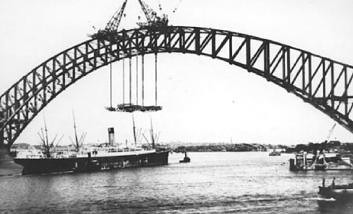 After the approach spans were erected, work began on the main arch. Two half-arches were built out progressively from each shore, each held back by 128 cables anchored underground through U-shaped tunnels. Steel members were fabricated in the workshops, placed onto barges, towed into position on the harbour and lifted up by two 580 tonne electrically operated creeper cranes, which erected the half-arches before them as they travelled forward.
After the approach spans were erected, work began on the main arch. Two half-arches were built out progressively from each shore, each held back by 128 cables anchored underground through U-shaped tunnels. Steel members were fabricated in the workshops, placed onto barges, towed into position on the harbour and lifted up by two 580 tonne electrically operated creeper cranes, which erected the half-arches before them as they travelled forward.On August 20, 1930, after the arch was successfully joined at 10pm the night before, the steel decking was then hung from the arch and was all in place within nine months, being built from the centre outwards to save time moving the cranes.
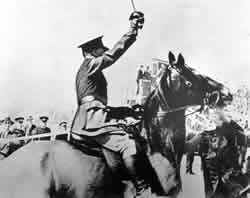 On Saturday 19 March 1932, the NSW Premier, the Hon. John T. Lang, officially declared the Bridge open. However, the opening did not go to plan with Captain Francis De Groot of the para-military group, the New Guard, riding up on his horse and slashing the ribbon prematurely with his sword, prior to the official cutting.
On Saturday 19 March 1932, the NSW Premier, the Hon. John T. Lang, officially declared the Bridge open. However, the opening did not go to plan with Captain Francis De Groot of the para-military group, the New Guard, riding up on his horse and slashing the ribbon prematurely with his sword, prior to the official cutting.Exercises:
On a new page in your books put the Heading “Sydney Harbour Bridge”. Under the heading write a 1/2 page summary based upon the information above. After you have completed the summary, write the following sub-headings and the questions in your books and answer them in full sentences using the links to the websites listed below.
History of the Bridge
1. Who had the original idea of building the Harbour Bridge and when?
2. What was the traffic allocation when it first opened?
3. Why did Francis De Groot cut the ribbon at the opening of the bridge?
4. How much movement due to the temperature is there in the bridge?
5. Using this link showing the earlier designs for the bridge, write down possible reasons you can come up with for deciding not to build one of the earlier designs.
Construction of the Bridge
1. When did the construction of the bridge begin and how many men did it take?
2. What were some of the jobs that these men did?
3. How many people died while building the bridge?
4. How did they test the strength of the road deck?
5. What happened to the workers after the bridge was finished?
Donald Bradman
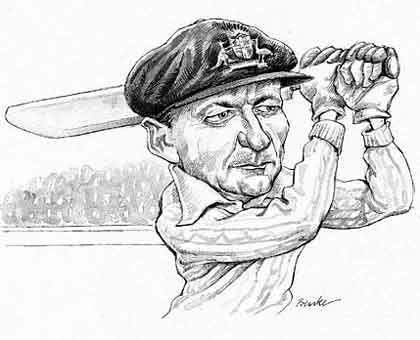 Sir Donald Bradman was born on 27 August 1908 in a rural town in New South Wales called Cootamundra. He grew up in Bowral as an athletic child where he began by playing backyard cricket. While at home he used to bounce an old golf ball off a water tank and hit it on the rebound with a cricket stump.
Sir Donald Bradman was born on 27 August 1908 in a rural town in New South Wales called Cootamundra. He grew up in Bowral as an athletic child where he began by playing backyard cricket. While at home he used to bounce an old golf ball off a water tank and hit it on the rebound with a cricket stump.The "Run-Making Machine", as he would become known in his later life, showed talent throughout his younger years, scoring his first century in the Bowral High School cricket team while still only twelve. At 17 he was a regular player for the Bowral senior team and during the 1925-1926 season, he made 1318 runs in 23 innings. He then progressed on to playing cricket for Sydney's St. George Club at a first grade level until he was selected in 1927 to join the New South Wales team.
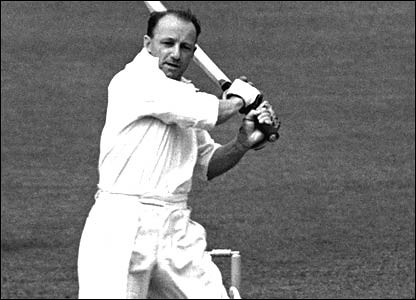 In 1928 he played his very first Test match representing Australia against England in the Ashes series, however it did not look to be a promising start. He scored only 18 runs in the first innings and 1 in the second. He was dropped from the Second Test, but was given a second chance for the Third Test. In the 1928-1929 season he amassed 1690 runs of which more than 700 were scored in the form of a century on the batting oval.
In 1928 he played his very first Test match representing Australia against England in the Ashes series, however it did not look to be a promising start. He scored only 18 runs in the first innings and 1 in the second. He was dropped from the Second Test, but was given a second chance for the Third Test. In the 1928-1929 season he amassed 1690 runs of which more than 700 were scored in the form of a century on the batting oval.Bradman's career in first-class cricket as a prodigious batsman extended for over two decades. One of the most memorable moments was during a match in the Sheffield Shield competition in 1930 when he made the highest personal score in a first-class match in Australia, 452 runs scored in a world record time of 415 minutes.
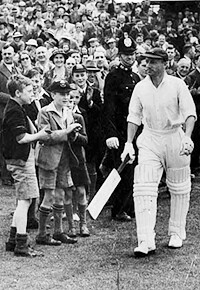 It was during this time that Bradman was beginning to become a significant figure not only in the sporting domain but also on the international scene, Australia itself was still finding its place in the world. It was a comparatively young nation compared to the rest of the world, and while it managed to escape the First World War with some heavy casualties and a newly established national character, it now faced the Great Depression.
It was during this time that Bradman was beginning to become a significant figure not only in the sporting domain but also on the international scene, Australia itself was still finding its place in the world. It was a comparatively young nation compared to the rest of the world, and while it managed to escape the First World War with some heavy casualties and a newly established national character, it now faced the Great Depression.During the Depression, the majority of the Australian public were without food, jobs and even homes. Every day was a constant struggle for them. It was a period of severe hardships and as a result many of them turned their attention to sport to take their minds off their situations. Cricket, in particular, has always been a sport for which Australians have felt deep affection. Even before the separate colonies of Australia were united by Federation and recognised as a nation, there was an Australian cricket team.
During the 1930s Donald Bradman boosted the morale of society and renewed their sense of national pride. Ordinary people could escape the worries of their daily lives by immersing themselves in stories of Bradman's heroic sporting feats. As a result, he was often described by others at the time as a 'bright star,' owing to the way he inspired people, even in the most desolate of times.
Exercises:
On a new page in your books put the Heading “Donald Bradman”. Under the heading write a 1/2 page summary based upon the information above. After you have completed the summary, write the following sub-headings and the questions in your books and answer them in full sentences using the links to the websites listed below.
"The Don"
1. Where did the Bradman family live when Donald was born?
2. What other activities was Donald involved in other than sport whilst he was at school?
3. How did Donald meet his wife?
4. How old was Donald when he left school at what did he do?
5. How did he get the title "Our Don"?
6. In your own words why was Bradman so significant?
7. In your own words what effects did Bradman have on Australian society?






 7:23 PM
7:23 PM
 Mark
Mark

 Posted in:
Posted in: 